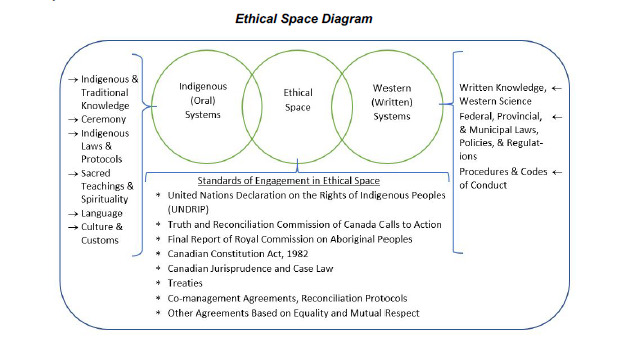Ethical Space of Engagement: Difference between revisions
Replaced content with "Within Inuit Nunangat vistas are horizonal outline of rock formations or shorelines. As they take particular shapes when viewed from a specific locations, they can be used to orient and (re-)direct one’s course when travelling (Aporta, ....). Within my research such vistas gesture towards the various ethical principles and guidelines that have guided me along the process of fieldwork In this particular case, you are presented with the guiding principles of the ‘..." Tag: Replaced |
No edit summary |
||
| Line 3: | Line 3: | ||
In this particular case, you are presented with the guiding principles of the ‘Ethical Space of Engagement’ (ESE), as proposed by Sturgeon Lake First Nation elder Willie Ermine (Ermine 2007). The ESE, is a “third space” approach, through which differentiated nations or collectives might negotiate ethical encounters with each other in an ‘ethical’ space that belongs to neither. This third space emerges both through principled practices (like for example negotiating terms of engagement), and as a condition for- in the case of my research- (non-)Indigenous- and Euro-Canadian knowledge systems to re-position themselves as more equitable partners-in-encounter (Ermine, 2007; Ermine 2015; Indigenous Circle of Experts 2018). | In this particular case, you are presented with the guiding principles of the ‘Ethical Space of Engagement’ (ESE), as proposed by Sturgeon Lake First Nation elder Willie Ermine (Ermine 2007). The ESE, is a “third space” approach, through which differentiated nations or collectives might negotiate ethical encounters with each other in an ‘ethical’ space that belongs to neither. This third space emerges both through principled practices (like for example negotiating terms of engagement), and as a condition for- in the case of my research- (non-)Indigenous- and Euro-Canadian knowledge systems to re-position themselves as more equitable partners-in-encounter (Ermine, 2007; Ermine 2015; Indigenous Circle of Experts 2018). | ||
[[File:Ethical Space of Engagement ( | [[File:Ethical Space of Engagement (IISSAAK OLAM FOUNDATION, 2019).png|border]] | ||
Figure 1: The Ethical Space Diagram, as published by the IISAAK OLAM foundation (2019) | Figure 1: The Ethical Space Diagram, as published by the IISAAK OLAM foundation (2019) | ||
Revision as of 18:54, 17 November 2024
Within Inuit Nunangat vistas are horizonal outline of rock formations or shorelines. As they take particular shapes when viewed from a specific locations, they can be used to orient and (re-)direct one’s course when travelling (Aporta, ....). Within my research such vistas gesture towards the various ethical principles and guidelines that have guided me along the process of fieldwork
In this particular case, you are presented with the guiding principles of the ‘Ethical Space of Engagement’ (ESE), as proposed by Sturgeon Lake First Nation elder Willie Ermine (Ermine 2007). The ESE, is a “third space” approach, through which differentiated nations or collectives might negotiate ethical encounters with each other in an ‘ethical’ space that belongs to neither. This third space emerges both through principled practices (like for example negotiating terms of engagement), and as a condition for- in the case of my research- (non-)Indigenous- and Euro-Canadian knowledge systems to re-position themselves as more equitable partners-in-encounter (Ermine, 2007; Ermine 2015; Indigenous Circle of Experts 2018).
 Figure 1: The Ethical Space Diagram, as published by the IISAAK OLAM foundation (2019)
Figure 1: The Ethical Space Diagram, as published by the IISAAK OLAM foundation (2019)
